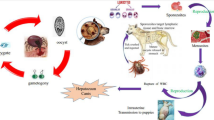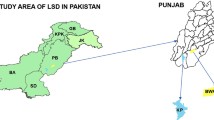Abstract
Tick-borne pathogens are causing severe diseases in livestock, wild animals, and humans. Wild animals play a crucial role in tick-borne pathogens’ transmission life cycle by serving as reservoir hosts or intermediate hosts, posing a continuous risk for domestic animals and humans. The presence of tick-borne pathogens is often ignored in wild animals kept in zoos, which is a public health concern. In the present study, we investigated these pathogens in tick-infested captive wild animals at the Lohi Bher zoo, Pakistan. Blood samples were collected from 22 animals, which include urials (4) (Ovis aries vignei), blackbucks (3) (Antilope cervicapra), fallow deer (1) (Dama dama), hog deer (6) (Axis porcinus), chinkaras (4) (Gazella bennettii), white tiger (2) (Panthera tigris tigris), a giraffe (Giraffa camelopardalis), and African lions (2) (Panthera leo). The samples were screened for Piroplasm and Anaplasma spp. by polymerase chain reaction targeting different gene loci. We detected three Theileria spp. and one Anaplasma sp. from the investigated captive wild animals. The Theileria sp. dama gazelle was detected from chinkara, Theileria sp. NG-2012b from chinkara and giraffe and T. parva from African lion, and Anaplasma bovis was identified in a giraffe. Moreover, Theileria sp. and Anaplasma sp. coinfection was detected in one giraffe. Overall, this study shows that Theileria spp. and Anaplasma spp. are circulating in captive wild animals, which can play an important role in their spread. Further studies are required to monitor tick-borne pathogens in zoo animals and their potential to spread from exotic wild captive animals to local wild and domestic.


Similar content being viewed by others
Data availability
Sequences are submitted in the GenBank database under accession numbers: MN209937–MN209941 for 18S rRNA and MN213735 for 16S rRNA.
References
Barlough JE, Madigan JE, DeRock E, Bigornia L (1996) Nested polymerase chain reaction for detection of Ehrlichia equi genomic DNA in horses and ticks (Ixodes pacificus). Vet Parasitol 63(3–4):319–329
Bendele KG (2004) Molecular characterization of Theileria spp. Using ribosomal RNA. Texas A&M University. http://oaktrust.library.tamu.edu/bitstream/handle/1969.1/2649/etd-tamu-2004B-2-VPAR-Bendele.pdf;sequence=1. Accessed 30 July 2022
Bouchard C, Dibernardo A, Koffi J, Wood H, Leighton PA, Lindsay LR (2019) N Increased risk of tick-borne diseases with climate and environmental changes. Can Commun Dis Rep 45(4):83–89. https://doi.org/10.14745/ccdr.v45i04a02
Buczek AM, Buczek W, Buczek A, Bartosik K (2020) The potential role of migratory birds in the rapid spread of ticks and tick-borne pathogens in the changing climatic and environmental conditions in Europe. Int J Environ Res Public Health 17(6). https://doi.org/10.3390/ijerph17062117
Chaisi ME, Sibeko KP, Collins NE, Potgieter FT, Oosthuizen MC (2011) Identification of Theileria parva and Theileria sp. (buffalo) 18S rRNA gene sequence variants in the African Buffalo (Syncerus caffer) in southern Africa. Vet Parasitol 182(2–4):150–62. https://doi.org/10.1016/j.vetpar.2011.05.041
Cutler SJ, Vayssier-Taussat M, Estrada-Pena A, Potkonjak A, Mihalca AD, Zeller H (2021) Tick-borne diseases and co-infection: current considerations. Ticks Tick Borne Dis 12(1):101607. https://doi.org/10.1016/j.ttbdis.2020.101607
de Castro JJ (1997) Sustainable tick and tick-borne disease control in livestock improvement in developing countries. Vet Parasitol 71(2–3):77–97. https://doi.org/10.1016/s0304-4017(97)00033-2
De La Fuente J, Massung RF, Wong SJ, Chu FK, Lutz H, Meli M, Von Loewenich FD, Grzeszczuk A, Torina A, Caracappa S, Mangold AJ (2005) Sequence analysis of the msp4 gene of Anaplasma phagocytophilum strains. J Clin Microbiol 43(3):1309–1317. https://doi.org/10.1128/JCM.43.3.1309-1317.2005
Donatien A, Lestoquard F (1936) Rickettsia bovis, nouvelle espece pathogene pour le boeuf. Bull Soc Pathol Exot 29:1057–1061
Farooq I, Moriarty TJ (2021) The impact of tick-borne diseases on the bone. Microorganisms 9(3). https://doi.org/10.3390/microorganisms9030663
Githaka N, Konnai S, Skilton R, Kariuki E, Kanduma E, Murata S, Ohashi K (2013) Genotypic variations in field isolates of Theileria species infecting giraffes (Giraffa camelopardalis tippelskirchi and Giraffa camelopardalis reticulata) in Kenya. Parasitol Int 62(5):448–453. https://doi.org/10.1016/j.parint.2013.06.002
Hassan MA, Liu J, Rashid M, Iqbal N, Guan G, Yin H, Luo J (2018) Molecular survey of piroplasm species from selected areas of China and Pakistan. Parasit Vectors 11(1):457
Iqbal N, Mukhtar MU, Yang J, Sajid MS, Niu Q, Guan G, Liu Z, Yin H (2019) First Molecular Evidence of Anaplasma bovis and Anaplasma phagocytophilum in Bovine from Central Punjab, Pakistan. Pathogens 8(3). https://doi.org/10.3390/pathogens8030155
Kang JG, Chae JB, Cho YK, Jo YS, Shin NS, Lee H, Choi KS, Yu DH, Park J, Park BK, Chae JS (2018) Molecular detection of Anaplasma, Bartonella, and Borrelia theileri in raccoon dogs (Nyctereutes procyonoides) in Korea. Am J Trop Med Hyg 98(4):1061–1068
Kawahara M, Rikihisa Y, Lin Q, Isogai E, Tahara K, Itagaki A, Hiramitsu Y, Tajima T (2006) Novel genetic variants of Anaplasma phagocytophilum, Anaplasma bovis, Anaplasma centrale, and a novel Ehrlichia sp. in wild deer and ticks on two major islands in Japan. Appl Environ Microbiol 72(2):1102–9. https://doi.org/10.1128/AEM.72.2.1102-1109.2006
Kelly P, Marabini L, Dutlow K, Zhang J, Loftis A, Wang C (2014) Molecular detection of tick-borne pathogens in captive wild felids, Zimbabwe. Parasit Vectors 7:514. https://doi.org/10.1186/s13071-014-0514-6
Lee M, Seo MG, Lee SH, Ouh IO, Kim YH, Kim JK, Goo YK, Rhee MH, Kim TH, Kwon OD, Kwak D (2018) Molecular detection and phylogenetic analysis of tick-borne pathogens in wild Korean water deer and farmed elk in Gyeongbuk and Gangwon Provinces of Korea. J Vet Med Sci 80(9):1473–1478. https://doi.org/10.1292/jvms.18-0307
Li Y, Chen Z, Liu Z, Liu J, Yang J, Li Q, Li Y, Luo J, Yin H (2016) Molecular survey of Anaplasma and Ehrlichia of red deer and sika deer in Gansu, China in 2013. Transbound Emerg Dis 63(6):e228–e236. https://doi.org/10.1111/tbed.12335
Liu J, Guan G, Liu Z, Liu A, Ma M, Bai Q, Yin H, Luo J (2013) Additional data for a new Theileria sp. from China based on the sequences of ribosomal RNA internal transcribed spacers. Exp Parasitol 133(2):217–21. https://doi.org/10.1016/j.exppara.2012.11.023
Liu Z, Ma M, Wang Z, Wang J, Peng Y, Li Y, Guan G, Luo J, Yin H (2012) Molecular survey and genetic identification of Anaplasma species in goats from central and southern China. Appl Environ Microbiol 78(2):464–470. https://doi.org/10.1128/AEM.06848-11
Mans BJ, Pienaar R, Latif AA (2015) A review of Theileria diagnostics and epidemiology. Int J Parasitol Parasites Wildl 4(1):104–118. https://doi.org/10.1016/j.ijppaw.2014.12.006
Namgyal J, Tenzin T, Checkley S, Lysyk TJ, Rinchen S, Gurung RB, Dorjee S, Couloigner I, Cork SC (2021) A knowledge, attitudes, and practices study on ticks and tick-borne diseases in cattle among farmers in a selected area of eastern Bhutan. PLoS ONE 16(2):e0247302. https://doi.org/10.1371/journal.pone.0247302
Norval RA, Lawrence JA, Young AS, Perry BD, Dolan TT, Scott J (1991) Theileria parva: influence of vector, parasite and host relationships on the epidemiology of theileriosis in southern Africa. Parasitology 102(Pt 3):347–356. https://doi.org/10.1017/s0031182000064295
Ogata S, Pereira JA, Jhonny LV, Carolina HP, Matsuno K, Orba Y, Sawa H, Kawamori F, Nonaka N, Nakao R (2021) Molecular survey of Babesia and Anaplasma infection in cattle in Bolivia. Vet Sci 8(9). https://doi.org/10.3390/vetsci8090188
Olmeda AS, Armstrong PM, Rosenthal BM, Valladares B, Del Castillo A, De Armas F, Miguelez M, Gonzalez A, Rodrıguez JR, Spielman A, Telford SR III (1997) A subtropical case of human babesiosis. Acta Trop 67(3):229–234
Parola P, Davoust B, Raoult D (2005) Tick- and flea-borne rickettsial emerging zoonoses. Vet Res 36(3):469
Peter SG, Aboge GO, Kariuki HW, Kanduma EG, Gakuya DW, Maingi N, Mulei CM, Mainga AO (2020) Molecular prevalence of emerging Anaplasma and Ehrlichia pathogens in apparently healthy dairy cattle in peri-urban Nairobi. Kenya BMC Vet Res 16(1):364. https://doi.org/10.1186/s12917-020-02584-0
Springer A, Glass A, Topp AK, Strube C (2020) Zoonotic tick-borne pathogens in temperate and cold regions of europe-a review on the prevalence in domestic animals. Front Vet Sci 7:604910. https://doi.org/10.3389/fvets.2020.604910
Tamura K, Dudley J, Nei M, Kumar S (2007) MEGA4: Molecular Evolutionary Genetics Analysis (MEGA) software version 4.0. Mol Biol Evol 24(8):1596–9. https://doi.org/10.1093/molbev/msm092
Torina A, Agnone A, Blanda V, Alongi A, D’Agostino R, Caracappa S, Marino AM, Di Marco V, de la Fuente J (2012) Development and validation of two PCR tests for the detection of and differentiation between Anaplasma ovis and Anaplasma marginale. Ticks Tick Borne Dis 3(5–6):283–287. https://doi.org/10.1016/j.ttbdis.2012.10.033
Yang JF, Li YQ, Liu ZJ, Liu JL, Guan GQ, Chen Z, Luo JX, Wang XL, Yin H (2014) Molecular evidence for piroplasms in wild Reeves’ muntjac (Muntiacus reevesi) in China. Parasitol Int 63(5):713–716. https://doi.org/10.1016/j.parint.2014.06.002
Yang J, Liu Z, Niu Q, Liu J, Han R, Guan G, Hassan MA, Liu G, Luo J, Yin H (2017) A novel zoonotic Anaplasma species is prevalent in small ruminants: potential public health implications. Parasit Vectors 10(1):1–6
Funding
This study was financially supported by the National Key R&D Program of China (2018YFD0502305, 2017YFD0501200, 2017YFD0502300); ASTIP (CAAS-ASTIP-2016-LVRI; NBCIS (CARS-37); 973 Program (2015CB150300); Jiangsu Co-Innovation Center program for Prevention and Control of Important Animal Infectious Disease and Zoonosis.
Author information
Authors and Affiliations
Contributions
MUM and NI performed the experiments and data analysis and drafted the manuscript. ZN participated in the sample collection. JY and TLP designed this study and critically revised the manuscript. The authors read and approved the final manuscript.
Corresponding author
Ethics declarations
Ethics approval and consent to participate
Animal treatments and sample preparation complied with the Animal Ethics Procedures and Guidelines and were approved by the Animal Ethics Committee of Lohi Bher zoo.
Consent to participate
Not applicable.
Consent for publication
Not applicable.
Conflict of interest
The authors declare no competing interests.
Additional information
Handling Editor: Una Ryan
Publisher's note
Springer Nature remains neutral with regard to jurisdictional claims in published maps and institutional affiliations.
Rights and permissions
Springer Nature or its licensor holds exclusive rights to this article under a publishing agreement with the author(s) or other rightsholder(s); author self-archiving of the accepted manuscript version of this article is solely governed by the terms of such publishing agreement and applicable law.
About this article
Cite this article
Mukhtar, M.U., Iqbal, N., Yang, J. et al. The first molecular identification and phylogenetic analysis of tick-borne pathogens in captive wild animals from Lohi Bher zoo, Pakistan. Parasitol Res 121, 3321–3326 (2022). https://doi.org/10.1007/s00436-022-07666-6
Received:
Accepted:
Published:
Issue Date:
DOI: https://doi.org/10.1007/s00436-022-07666-6




